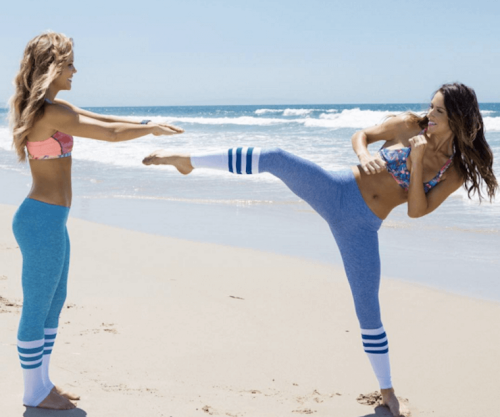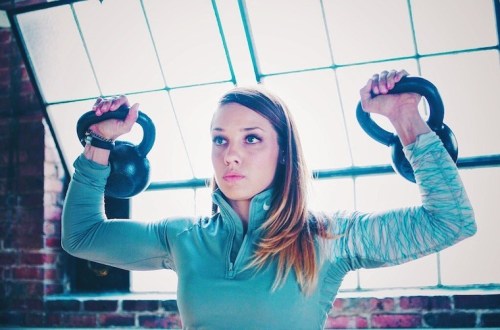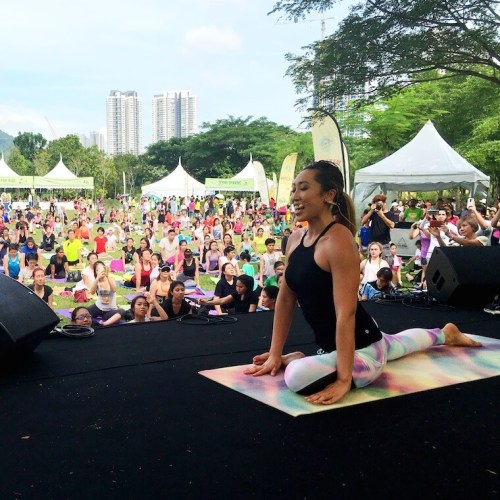In defense of Instagram-famous trainers
These days, fitness pros are taking to social media to offer tips and at-home workouts—but are they legit? Amanda Bisk, Cassey Ho, and more weigh in.

Back in the days when Richard Simmons and Buns of Steel reigned, only the most elite fitness pros had the privilege of making exercise videos. (Well, celebrities, too—hello, Jane Fonda!—but even they had seasoned trainers advising them off-camera.)
Oh, how the world has changed. Today, anyone with an iPhone and a sports bra can film her workout routine, add a filter or two, upload it to YouTube or Instagram, and label herself a fitness expert. And not everyone is happy about it.
Back in June, dance cardio powerhouse Anna Kaiser candidly aired her concerns about the rise of social media trainers to Business Insider. “They’re not educated in fitness, and [social media stars] don’t actually get to interact with people,” she said, noting that this lack of in-person oversight from a trainer is a recipe for injury. “It’s frustrating to see how important a social media following is in the world of fitness, because people who have sexy pictures of themselves have a lot more followers than someone who’s trying to really do it well and maintain integrity.”
“People who have sexy pictures of themselves have a lot more followers than someone who’s trying to really do it well and maintain integrity.”
Louise Burke, head of sports nutrition at the Australian Institute of Sport, has also spoken publicly about the danger of copying moves seen on Instagram. As she told Body+Soul last year: “[Social media] overly simplifies information when you’re trying to limit it to a photo or 140 characters, and this can lead to injuries [on] a physical level.”
But this isn’t dissuading millions of people from following online trainers’ workout plans, eating their signature recipes, buying their leggings, and attending their stadium-sized classes and big-budget retreats IRL. (Yes, social media workout icons are officially the new rock stars.) And when they’re getting so many women hooked on fitness—many of whom may never have set foot in a gym otherwise—can they really be so bad?
Here, three online fitness stars open up about the biggest myths, challenges, and benefits that come with training in the digital world. Read on for their ultra-enlightening prerogatives.

Credentials are everything (and a lot of online trainers do have them)
First thing’s first—among the most successful online fitness trainers, many do have some seriously impressive qualifications behind them, which dispels the myth that you’ll always get more quality instruction in person than online.
Australian mega-star Kayla Itsines has been working as a certified personal trainer for almost a decade and fronted her own studio before launching her Bikini Body Guides and Sweat with Kayla apps. Pole vaulter-turned-yogi and trainer Amanda Bisk has a bachelors degree in sports science. And Katrina Scott, one-half of the duo behind Tone It Up, clocked many hours working with clients at Equinox before she filmed her first YouTube video. (She met her partner-in-planks, Karena Dawn, while on the job).
Of course, there are plenty of people doling out digital fitness advice who aren’t formally qualified to do so. But those who do have legitimate cred say it’s unfair to lump all online trainers together, since there’s such a wide range of education and experience out there.

“Getting correct information is one of the most important elements of trusting anything online,” says Bisk. “There is so much junk [on the Internet] and unfortunately, that has snuck into the fitness industry, too.” Her advice? “Make sure the ‘experts’ you are trusting are fully qualified in their profession. Do your research and look for degrees or qualifications from renowned schools, colleges, or universities.”
Pop Pilates founder Cassey Ho, another online fitness star with multiple certifications and a decade of experience under her belt, adds that there are a few other things you should look for, beyond just letters after a trainer’s name. “You should be looking at the person’s form,” she says, adding that it’s also important to pay attention to what they say. “If you’re trying something and they’re not explaining it to you [clearly] or it’s feeling weird, you know they aren’t effectively teaching you.” And if that’s the case, keep on scrolling.

But is online training safe?
Many critics of online trainers claim that injury risk increases when an instructor isn’t physically present to correct her students’ form—and this is something that a lot of super-qualified Instagram fitness stars actually agree with.
“When I go to meet-ups and teach my classes, I notice there are people who don’t have any body awareness—their form is totally off,” says Ho. She’s responded by creating a live version of her Pop Pilates method, which is currently available in 24 Hour Fitness gyms across the country. Her hope is that beginners will learn the basics in person with an instructor, and then carry on their workouts at home with her YouTube videos. “My biggest goal is getting the workout into more gyms,” she says. “There’s nothing that can replace being in a live class and being able to perfect your form.”

Instagram-famous fitness pro Kaisa Keranen is also a big advocate of starting in the gym before following an online fitness program. “My biggest issue with online training is that I am not there to coach you through the movements and make corrections where necessary,” says Keranen, who has a master’s degree in sports performance and injury prevention (and almost 250K Insta-followers). “Find a local trainer to get you moving first. I think it is so important! That way, they can work with you to build a strong foundation of movement and an understanding of your body.”
“Online coaching is all about how intelligent of a program you can create for the general population and how well you can coach them through it from the other side of the screen.”
Keranen is quick to point out, however, that this challenge does have a silver lining—it’s forced her to be more creative when it comes to designing workouts that anyone can do with little supervision and minimal risk, no matter what their fitness level. (Because, let’s face it, most people do online workouts because they don’t want to spend time at the gym.)
“The goal with my new series [which comes out October 11] is for someone with a good base of movement to be able to up their game,” she says. “I think online coaching is all about how intelligent of a program you can create for the general population and how well you can coach them through it from the other side of the screen. I feel a strong responsibility to raise the bar in our industry.” And if the decades-old fitness video market has taught us anything, it’s that this can be done—I mean, how many people are warning of the dangers of workout DVDs? Content is just accessed differently today.

Grooming a new—and powerful—generation of fitness addicts
Despite the criticism that’s often lobbed at online trainers, one thing’s for sure—they’ve made a lot of people fall in love with fitness who may not have done so otherwise.
Ho says her fan base is largely comprised of teens and 20-somethings who are establishing healthy habits for the first time with her programs. “A lot of times, Pop Pilates is the first workout [my fans] will ever try,” she says. “It’s been so great to show the younger generation what Pilates is while keeping it cool, fresh, and relevant.”
“Fitness can be quite overwhelming sometimes, so technology can play an important role in empowering people to make their own decisions about their health.”
Bisk agrees, adding the accountability that comes along with having an online #fitfam is a huge draw to the digital medium. “Fitness can be quite overwhelming sometimes, so technology can play an important role in empowering people to make their own decisions about their health,” she says. “I see so many of my followers get excited about getting active each day, building great exercise routines, and really taking charge of what they want out of their fitness. It’s really inspiring.”
And even though skimpy outfits and six-packs are standard fitfluencer fare, many of them use their fame as a platform to talk about body positivity and self-love in more depth than they ever could during a one-hour studio class.
Ho, for one, has been very open with her community about her struggles with orthorexia and self-image—the video above is a commentary on body shaming, based on her own personal experience. “I don’t think I’d be able to do the same thing if I was just working at a gym,” she says.
Keranen is another trainer whose M.O. is just as much about fostering positive body image as it is about burpees. “To me, movement has nothing to do with looks—it’s about pushing your body and being proud of what you achieved,” she says. “The reason I get up and move every day isn’t to fit into a bikini—it’s so the positive relationship I have with my body continues to grow. I love my body and am extremely grateful for all that it does for me, and I think that comes across on my page.”
So sure, there’s a lot of noise in the online fitness world, but there are also many super-smart, innovative, and capable trainers who are inspiring legions of women to get off the couch and break a sweat. And that’s worth just as much as having one’s name on a studio door, don’t you think?
Short-term fitness challenges are another big Instagram trend—but do they work? Two experts weigh in. And when it comes to social media crazes that are undeniably awesome, mermaid thighs and sweet potato toast both rank high.
Sign Up for Our Daily Newsletter
Get all the latest in wellness, trends, food, fitness, beauty, and more delivered right to your inbox.
Got it, you've been added to our email list.










